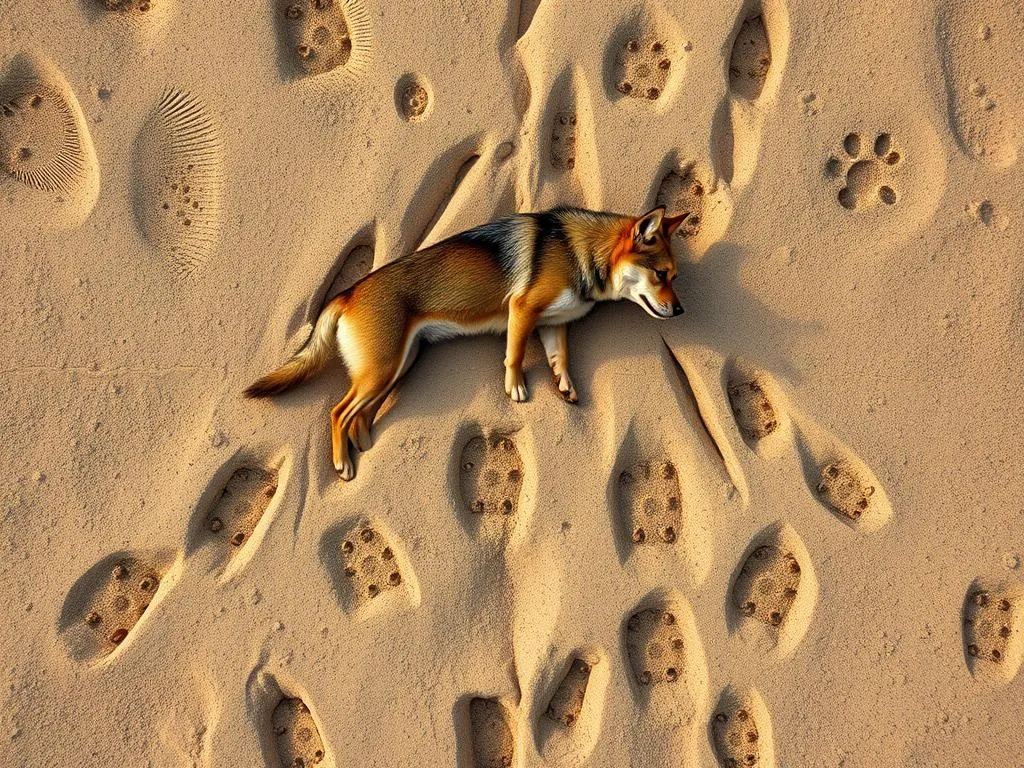
Introduction
Tracking animals in nature is a fascinating skill that allows us to connect with wildlife and understand their behaviors. Among the various animals we encounter, dogs and coyotes often leave behind tracks that can be confusing to differentiate. These two species, while similar in some aspects, have distinct characteristics that can help you tell their tracks apart. This guide will provide you with the knowledge you need to identify and appreciate the nuances of dog and coyote tracks.
Understanding Animal Tracks
What Are Animal Tracks?
Animal tracks, or footprints, are the impressions left behind by animals as they walk, run, or play. These tracks serve as vital indicators of the species present in a particular area and can reveal a wealth of information about their behavior, movement patterns, and even their health. Understanding animal tracks involves looking at the anatomy of the footprints, including the size, shape, and arrangement of the paw pads and claw marks.
The Significance of Identifying Tracks
For wildlife enthusiasts, hikers, and pet owners, identifying tracks is more than just a fun activity; it provides insight into the ecosystem. By recognizing dog and coyote tracks, you can better understand the wildlife in your surroundings, contribute to conservation efforts, and even ensure the safety of your pets. Knowing how to distinguish between these tracks can also enhance your outdoor experiences and foster a deeper appreciation for nature.
Basic Characteristics of Dog and Coyote Tracks
General Differences
When comparing dog and coyote tracks, several general differences become apparent.
-
Size Comparison: Coyote tracks are generally larger than those of most domestic dogs. On average, coyote tracks measure about 2.5 to 3.5 inches in length, while dog tracks can vary significantly depending on the breed but often range from 1.5 to 3 inches.
-
Shape and Configuration: Coyote tracks are typically more elongated and narrower than dog tracks, which can appear rounder and broader.
Specific Features of Dog Tracks
Dog tracks exhibit unique characteristics that can help differentiate them from coyote tracks.
-
Paw Pad Structure: Domestic dogs usually have a more prominent paw pad structure. Most dog tracks show four toes with noticeable claw marks, and you might see the “webbing” between the pads.
-
Common Patterns: In urban settings, dog tracks often appear more numerous due to the presence of pet owners walking their dogs, leading to a higher concentration of tracks. In contrast, rural areas may show a mix of domestic dog and wild animal tracks.
Specific Features of Coyote Tracks
Coyote tracks have distinct features that set them apart from dog tracks.
-
Paw Pad Structure: Coyote tracks typically show four toes that are less rounded than a dog’s. The pads are more oval-shaped and closely spaced, giving the impression of a more streamlined foot.
-
Common Patterns: Coyotes are more likely to leave tracks in wild areas, such as forests and grasslands. Their tracks can often be found alongside signs of their hunting habits, like small animal remains or scat.
Detailed Comparison of Tracks
Paw Size and Shape
When measuring tracks, coyote tracks are noticeably larger and longer compared to most dogs.
-
Measurement Comparisons: Coyote tracks can be measured as 2.5 to 4 inches in length and about 2 to 3 inches in width, while dog tracks vary between 1.5 to 3 inches in length and width depending on the breed.
-
Differences in Overall Shape: The overall structure of a coyote’s track tends to be more elongated, while dog tracks can appear more rounded. This elongation can help in identifying the tracks as belonging to a coyote.
Claw Marks
One major difference between dog and coyote tracks is the visibility of claw marks.
-
Distinction of Claw Visibility: While dogs generally show prominent claw marks, coyotes may display less visible claws, which can be more subtle due to their hunting style. Coyote tracks may show slightly less claw imprint because their claws retract when walking, while dog claws tend to be more visible.
-
Details on Behavior: The presence or absence of claw marks can indicate the animal’s behavior. For example, a dog might leave deeper claw marks due to its more playful and less cautious nature, while a coyote’s tracks may suggest stealth and agility.
Gait Patterns
Understanding the gait patterns of dogs and coyotes is crucial for tracking.
-
Analysis of Movement: Coyotes often have a more fluid gait, allowing them to traverse various terrains more efficiently. In contrast, dogs may show a more erratic pattern, influenced by their individual playfulness or excitement.
-
Examples of Walking, Running, and Trotting: A coyote’s tracks may appear spaced farther apart when it is running, while a dog might leave closely spaced tracks during play. Observing these patterns can provide additional context for identifying tracks.
Environmental Context
Habitat Differences
The habitats of dogs and coyotes can influence the visibility and type of tracks found.
-
Common Habitats: Coyotes are adaptable and can thrive in diverse environments, including forests, grasslands, and even urban areas. Domestic dogs, however, are often found in residential areas, parks, or designated walking paths.
-
Influence on Track Visibility: The environment affects track visibility; for example, tracks in soft soil or snow are easier to identify than those in hard, rocky ground. Understanding these factors can enhance your tracking experience.
Seasonal Changes
Seasonal factors significantly affect the appearance of tracks.
-
How Seasonal Factors Affect Appearance: In winter, snow can preserve tracks, making them easier to identify. Conversely, rain can wash away footprints, making them less visible.
-
Tips for Tracking in Different Weather Conditions: After a snowfall, tracking can be particularly rewarding as the soft surface captures clear impressions. On rainy days, try to look for tracks in muddy areas where they may still be prominent.
Practical Tips for Identifying Tracks
Tools for Track Identification
To improve your tracking skills, consider using a few helpful tools.
-
Recommended Tools: A good animal track guidebook can be invaluable, along with a camera for documentation and a measuring tape to record track sizes accurately. Binoculars might also help you spot animals in the distance.
-
How to Take Clear Photographs: Capture images of tracks from various angles and distances to provide context. This will aid in later identification and analysis.
Best Practices for Tracking
Engaging in wildlife tracking should be done thoughtfully and ethically.
-
Guidelines for Sustainable Observation: Always respect wildlife by keeping a safe distance and minimizing your impact on their natural habitat. Avoid stepping on tracks as you observe them.
-
Ethical Considerations: Ensure that your tracking does not disturb the animals or their environment. Educate yourself on local wildlife regulations and adhere to them for responsible tracking.
Resources for Further Learning
Books and Field Guides
For those eager to dive deeper into tracking, several books and field guides can expand your knowledge.
- Recommended Reading: Look for resources that focus on animal identification and tracking techniques. Titles that cover both dogs and coyotes will be particularly useful.
Online Communities and Forums
Engage with other enthusiasts through online platforms.
- Suggestions for Online Platforms: Joining forums or social media groups dedicated to wildlife tracking can provide valuable insights. Sharing your experiences and learning from others can enhance your understanding of tracking.
Conclusion
Recognizing the differences between dog and coyote tracks enriches your outdoor experiences and deepens your connection with nature. The characteristics of each track, including size, shape, and environmental context, provide essential clues for identification. As you embark on your tracking adventures, remember to observe ethically and sustainably, ensuring that you respect the wildlife in your environment. Embrace the joy of discovering animal tracks and the stories they tell about the world around you.









